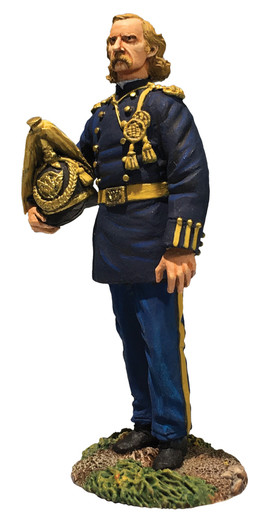Lieutenant Colonel George Armstrong Custer
Apr 19th 2019
Enough has been written about Lt. Col. George Armstrong Custer to fill several volumes; so lets add another page. To begin I wish to announce that a toy soldier figure ,Lt. Col. George Armstrong Custer, produced by WBritain and sold exclusively by Trains and Toy Soldiers, will be released in June of 2019. 1/30 scale matte finish 1 piece set.
The following information has been taken from History.com and condensed for use in this blog.
George Armstrong Custer was a U.S. military officer and commander who rose to fame as a young officer during the American Civil War. He gained further fame for his post-war exploits against Native Americans in the West. Custer’s death at the Battle of the Little Bighorn in 1876 – now infamous as Custer’s Last Stand – made him a martyr for American expansionism, although he had been harshly criticized for his actions and remains a controversial figure. George Armstrong Custer was born in New Rumley, OH, on December 5, 1839. Custer was part of a large extended family, and spent part of his youth in living in Michigan, with a half-sister and her husband, and would consider the state his adopted home.
He attended Michigan schools and taught for a short period. Despite his humble background and youthful indiscretions, a Michigan Congressman secured Custer a place at West Point Military Academy when he was 18.
Custer arrived in 1857. While intelligent and talented, he dismissed the Academy’s disciplinary system and was a lazy student. He was nearly expelled several times. He racked up 726 demerits in just four years – one of the highest amounts in West Point history – and graduated last in his class, a position commonly known as the “goat.”
Custer got his first taste of war mere weeks after his graduation, at the The First Battle of Bull Run in July 1861. Where he soon joined McClellan’s staff, and fought during the Peninsula Campaign that began in the spring of 1862.
Custer earned a reputation for both bravery and brashness. He also became known as a publicity hound, taking every opportunity to get himself in front of the cameras and newspapermen documenting the war.
In the summer of 1863, the 23-year-old Custer was promoted to brigadier general of volunteers, and took command of the Michigan Calvary Brigade. Soon after, he began sporting an unusual and flamboyant uniform, which brought him even more attention.
Custer played a key role at the Battle of Gettysburg, where he later captured Confederates fleeing south after the Union victory. His brigade lost more than 250 men, the highest of any Union cavalry unit. Custer’s units would continue to rack up a disproportionate number of casualties throughout the war. Moving on to Lt. Col. George Armstrong Custer in the West. He served in the Southwest immediately after the American Civil War and upon the newly raised 7th Cavalry Regiment he assumed command as a lieutenant colonel. He arrived in Kansas the fall of 1866 and participated in a campaign against the Sioux and Cheyenne in the spring. Shortly afterwards he was court-martialed for leaving his command. In the fall of 1868 he returned to fight in the Indian Wars.
In 1875, President Grant ordered all Sioux out of the Black Hills of South Dakota and Wyoming by the end of the following January. Well aware that they would be unable to make the trek during a harsh winter, the government planned to use this as an excuse to expand hostilities.
These actions broke the terms of the 1868 Treaty of Fort Laramie, which had recognized the Black Hills as Sioux land. But in 1874, gold had been discovered in the region and the U.S. government wanted to permanently remove the Sioux. Among those who resisted American aggression was Sitting Bull, a Hunkpapa Lakota chief and holy man. The U.S. campaign began in mid-May and on June 25th Custer's scouts spotted the camp of an estimated gathering of 2000 Cheyenne and Arapaho along the Little Bighorn River in Montana.
Custer and his 210 men headed north, into the Battle of the Little Bighorn, never to be seen alive again. It was Custer's last stand.


